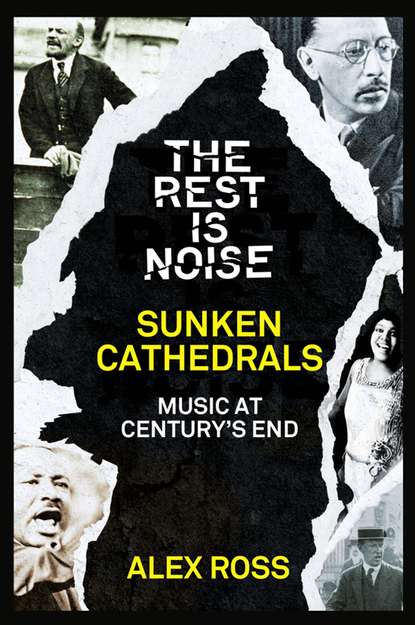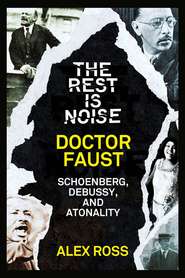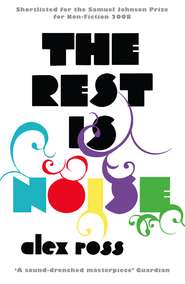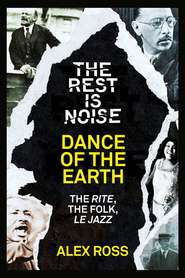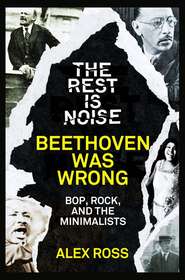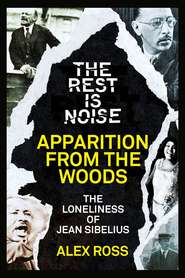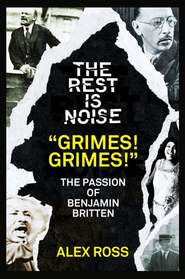По всем вопросам обращайтесь на: info@litportal.ru
(©) 2003-2024.
✖
The Rest Is Noise Series: Sunken Cathedrals: Music at Century’s End
Автор
Год написания книги
2018
Настройки чтения
Размер шрифта
Высота строк
Поля
Alex Ross
This is a chapter from Alex Ross’s groundbreaking history of twentieth-century classical music, ‘The Rest is Noise’. Further extracts are available as digital shorts, accompanying the London Southbank festival programme.How can composition in the twentieth century be summarised? Styles of every description – minimalism, post-minimalism, electronic music, laptop music, Internet music, appropriations of rock, pop and hip-hop, experimental folkloristic music in Latin America, the Far East, Africa and the Middle East – jostle against each other, none gaining supremacy. ‘The Rest is Noise’ has been an aerial tour of this ever-changing landscape.Now a major festival running throughout 2013 at London’s Southbank, The Rest is Noise is an intricate commentary not just on the sounds that defined the century, but on art’s troublesome dance with politics, social and cultural change.Alex Ross is the New Yorker’s music critic, and the winner of the Guardian First Book Award and the National Book Critics Circle Award for The Rest is Noise, which was also shortlisted for the Samuel Johnson and Pulitzer prizes for non-fiction.
This is a chapter from Alex Ross’s groundbreaking history of 20
century classical music, The Rest is Noise.
It is released as a special stand-alone ebook to celebrate a year-long festival at the Southbank Centre, inspired by the book. The festival consists of a series of themed concerts. Read this chapter if you’re attending concerts in the episode
New World Order: No More Rules
Alex Ross, music critic for the New Yorker, is the recipient of numerous awards for his work, including an Arts and Letters Award from the American Academy of Arts and Letters, the Belmont Prize in Germany and a MacArthur Fellowship. The Rest is Noise was his first book and garnered huge critical acclaim and a number of awards, including the Guardian First Book Award and the National Book Critics Circle Award. He is also the author of Listen to This.
SUNKEN CATHEDRALS
Music at Century’s End
From The Rest Is Noise by Alex Ross
Contents
Sunken Cathedrals (#u7cff2a2d-6661-5e74-8753-c8d3794522ad)
Notes (#litres_trial_promo)
Suggested Listening and Reading (#litres_trial_promo)
Copyright (#litres_trial_promo)
About the Publisher (#litres_trial_promo)
15
SUNKEN CATHEDRALS
Music at Century’s End
As Highway 1, the California coastal highway, goes north of San Francisco, it holds the eyes like a work of art. The landscape might have been devised by a trickster creator who delights in grand gestures and abrupt transitions. Rolling meadows end in cliffs; redwood trees rise above slender patches of beach. Towers of rock rest on the surface of the ocean like the ghosts of clipper ships. A lost cow sits on the shoulder, looking out to sea. Side roads head up the inland hills at odd angles, tempting the aimless driver to follow them to the end. One especially beguiling detour, the Meyers Grade Road, departs from Highway 1 shortly after the town of Jenner. The grade is 18 percent, and the steepness of the ascent causes dizzying distortions of perspective. The Pacific Ocean rises in the rearview mirror like a blue hill across a hidden valley.
Not far from here is Brushy Ridge, the forest home of the composer John Adams. One way to describe his work is to say that it sounds like Highway 1. It is a cut-up paradise, a stream of familiar sounds arranged in unfamiliar ways. A glitzy Hollywood fanfare gives way to a trancelike sequence of shifting beats; billowing clouds of Wagnerian harmony are dispersed by a quartet of saxophones. It is present-tense American romanticism, honoring the ghosts of Mahler and Sibelius, plugging into minimalist processes, swiping sounds from jazz and rock, browsing the files of postwar innovation. Sundry sounds are broken down and filtered through an instantly recognizable personal voice, sometimes exuberant and sometimes melancholy, sometimes hip and sometimes noble, winding its way through a fragmentary culture.
Brushy Ridge is at the far end of the Meyers Grade Road, and the last part of the drive is a matter of guesswork. The Adams house, at the top of a rocky hill, is a comfortable, earthy, rural-hippie kind of place; not too long ago, it served as the headquarters for a pot farm. Walking in, you might find the composer asleep on the couch with the collected poems of Allen Ginsberg lying open in front of him. He has a youthful face, framed by a neat, silvery beard. His eyes are sometimes bright with curiosity, sometimes clouded with a slight sadness. There is an appealing innocence about him, but it is an innocence sharpened by confidence. He speaks in mild, unhurried tones, halting to look for the right words. On occasion, he breaks into an unexpectedly aggressive cackle, underscoring it with a clap of his hands and a merry roll of his eyes.
Adams makes his way across a ravine to a modern ware house. “My composing shed,” he calls it. There is a tradition of composers working in the woods; Sibelius’s Ainola is surrounded by a stand of forest, and Mahler wrote most of his symphonies in rustic one-room studios constructed to his specifications. Adams can claim the largest composing hut in history. He raises the overhead door and walks through the space, part of which is rented out to a woodcutter neighbor. There is a sharp smell of freshly cut redwood. He goes into a smaller room, where sheets of music paper are scattered around an electronic keyboard and a computer terminal.
It is the year 2000, and Adams is writing an oratorio called El Niño—a latter-day, Spanish-inflected retelling of the Christmas story. He fiddles with the keyboard, commanding the computer to play an aria for mezzo-soprano and orchestra titled “Pues mi Dios ha nacido a penar,” or “Because My Lord Was Born to Suffer.” In meekly peeping tones, the computer sings a sinuous, long-breathed melody, twisting and turning over lullaby chords. After about fifty bars the music trails off into a single line. The composer stares at the floor, cupping his chin in his hand. Then he goes back to work, chipping away at the silence of everything that remains to be composed.
After the End
This has been a book about the fate of composition in the twentieth century. The temptation is strong to see the overall trajectory as one of steep decline. From 1900 to 2000, the art experienced what can only be described as a fall from a great height. At the beginning of the century, composers were cynosures on the world stage, their premieres mobbed by curiosity seekers, their transatlantic progress chronicled by telegraphic bulletins, their deathbed scenes described in exquisite detail. On Mahler’s last day on earth, the Viennese press reported that his body temperature was wavering between 37.2 and 38 degrees Celsius. A hundred years on, contemporary classical composers have largely vanished from the radar screen of mainstream culture. No one whispers “Der Adams!” as the composer of El Niño walks the streets of Berkeley.
From a distance, it might appear that classical music itself is veering toward oblivion. The situation looks especially bleak in America, where scenes from prior decades—Strauss conducting for thousands in Wanamaker’s department store, Toscanini playing to millions on NBC radio, the Kennedys hosting Stravinsky at the White House—seem mythically distant. To the cynical onlooker, orchestras and opera houses are stuck in a museum culture, playing to a dwindling cohort of aging subscribers and would-be elitists who take satisfaction from technically expert if soulless renditions of Hitler’s favorite works. Magazines that once put Bernstein and Britten on their covers now have time only for Bono and Beyoncé. Classical music is widely mocked as a stuck-up, sissified, intrinsically un-American pursuit. The most conspicuous music lover in modern Hollywood film is the fey serial killer Hannibal Lecter, moving his bloody fingers in time to the Goldberg Variations.
Seen from a more sympathetic angle, the picture is quite different. Classical music is reaching far larger audiences than it has at any time in history. Tens of millions show up from night to night in opera houses, concert halls, and festival grounds. Huge new audiences have materialized in East Asia and South America. While the repertory is preternaturally resistant to change, it is being permeated by twentieth-century music. Stravinsky’s Rite, Bartók’s Concerto for Orchestra, and Shostakovich’s Fifth Symphony are beloved orchestral showpieces; works of Strauss, Janáček, and Britten have joined Mozart and Verdi in the opera repertory. Young audiences crowd into small halls to hear Elliott Carter’s string quartets or Xenakis’s stochastic constructions. Living composers such as Adams, Glass, Reich, and Arvo Pärt have acquired a semblance of a mass following. And a few farsighted orchestras have put modern repertory front and center: in 2003, the Los Angeles Philharmonic, under the visionary direction of Esa-Pekka Salonen, inaugurated Walt Disney Concert Hall with a program that included Ligeti’s Lux aeterna, Ives’s The Unanswered Question, and, naturally, the Rite. As the behemoth of mass culture breaks up into a melee of subcultures and niche markets, as the Internet weakens the media’s stranglehold on cultural distribution, there is reason to think that classical music, and with it new music, can find fresh audiences in far-flung places.
There is little hope of giving a tidy account of composition in the second fin de siècle. Styles of every description—minimalism, post-minimalism, electronic music, laptop music, Internet music, New Complexity, Spectralism, doomy collages and mystical meditations from Eastern Europe and Russia, appropriations of rock, pop, and hip-hop, new experiments in folkloristic music in Latin America, the Far East, Africa, and the Middle East—jostle against one another, none achieving supremacy. Some have tried to call the era postmodern, but “modernism” is already so equivocal a term that to affix a “post” pushes it over the edge into meaninglessness. In retrospect, modernism, in the sense of a unified vanguard, never existed. The twentieth century was always a time of “many streams,” a “delta,” in the wise words of John Cage. What follows is an aerial tour of an ever-changing landscape.
Composing remains, as Thomas Mann’s Devil says, “desperately difficult.” Although vast quantities of music are being written down day by day—national websites display lists of 450 composers in Australia, 650 composers in Canada, several thousand in the Nordic countries—few of them have found an audience outside a relatively limited clique of new-music fanciers. Some specialize in “music for use,” writing for church choirs or collegiate wind bands or the soundtracks of video games. The majority make a living by teaching composition, and their students usually become teachers themselves. They may sometimes ask, with the title character of Hans Pfitzner’s Palestrina, “What is it for?” They have read in books that their fore-bears humbled kings, electrified crowds, forged nations. Sooner or later they realize that modern popular culture has no place for a composer hero. The most celebrated composers are sometimes the unhappiest; György Ligeti, in his last years, was reportedly haunted by the feeling that he would be forgotten after his death, that he had outlived the age in which music mattered.
Perhaps Ligeti was right; perhaps classical composition is being sustained past its date of expiration by the stubborn determination of those who perform it, those who support it, and, above all, those who write it. More likely, though, a thousand-year-old tradition won’t expire with the flipping of a calendar or the aging of a baby-boom cohort. Confusion is often a prelude to consolidation; we may even be on the verge of a new golden age. For now, the art is like the “sunken cathedral” that Debussy depicts in his Preludes for Piano—a city that chants beneath the waves.
After Europe
“The symphony must be like the world,” Mahler said to Sibelius in 1907. “It must be all-embracing.” Now classical music is the world; it has ceased to be a European art. You can use new works to draw a map of the globe—from the orchestral pieces of the Australian composer Peter Sculthorpe, which draw on the sounds and rhythms of the Australian outback, to R. Murray Schafer’s radical music-theater cycle Patria, which can only be performed in the forests and lakes of the Canadian north. A comprehensive list of significant voices in contemporary music would include Franghiz Ali-Zadeh of Azerbaijan, Chen Yi of China, Unsuk Chin of South Korea, Sofia Gubaidulina of Russia, Kaija Saariaho of Finland, and Pauline Oliveros of the United States. Composition has also ceased to be predominantly male; the preceding six composers are all women.
In one of the primal scenes of modern music, Debussy fell in love with Javanese and Vietnamese ensembles at the Paris Universal Exposition of 1889. Appropriately, the first internationally renowned composer to emerge from Asia—Tōru Takemitsu—found his voice by listening to French music. Toward the end of the Second World War, soldiers and civilians on the Japanese home front constructed networks of underground bases, in anticipation of an invasion that never came. Takemitsu was stationed in one of these dugout fortresses in 1944, all of fourteen years old. Although no music aside from patriotic songs was permitted at the base, one day a kind-hearted officer ushered the child-soldiers into a back room and played them some records, using a windup phonograph with a bamboo needle. One disk had Lucienne Boyer singing “Parlez-moi d’amour.” Takemitsu listened, he later said, in a state of “enormous shock.” After so much sunless, soulless labor, that winsome chanson opened a world of possibility in his mind. Ever after, he honored the moment as the birth of his musical consciousness.
Largely self-taught, Takemitsu first studied Debussy and Messiaen, then moved on to Boulez and Cage. He refined his technique not only in concert works but in scores for various masterpieces of postwar Japanese cinema, including Akira Kurosawa’s Dodes’ka-den and Hiroshi Teshigahara’s Woman in the Dunes. In the former he seduced the ears with popular airs, in the latter he raised goosebumps with Xenakis-like string glissandos and electronic noise. Like Messiaen, Takemitsu felt no need to choose between the sweet and the harsh. In the sixties, inspired partly by his film work, he added Japanese instruments such as shakuhachi flute and biwa lute to his Western-based ensembles. By the time of his early death, in 1996, Takemitsu had forged a late style that was precise in design, rich in timbre, tonal on the surface, mysterious at the core. He compared his music to a “picture scroll unrolled.”
Chinese music has been operating at a high level of sophistication for several thousand years. The bianzhong bells of Marquis Yi, which rested undisturbed in a tomb for twenty-four hundred years before being uncovered in 1978, are meticulously tuned in twelve-note octaves, close to the modern Western chromatic scale. Nonetheless, in the early decades of the twentieth century, Chinese composers defected from native traditions toward the West. They initially emulated Russian composers, and, a little later, Debussy, whose pentatonic harmony sounded as familiar to the Chinese as it did to Takemitsu in Japan. Sheila Melvin and Jindong Cai’s absorbing history, Rhapsody in Red: How Western Classical Music Became Chinese, offers a telling anecdote about the conversation between East and West. Some years ago, an American visitor to China commented that one composer’s music sounded like Debussy’s. The composer answered in irritation, “No, this piece doesn’t resemble Debussy! Not at all! Debussy resembles me! Debussy resembles China!”
When Mao Zedong and the Communists took power in 1949, composers found themselves in a recognizable predicament. Like Hitler and Stalin, Mao fancied himself a patron of the arts, and he meddled incessantly in the cultural sphere, zigzagging between liberalization and repression. In the “Let a hundred flowers bloom” period of the late fifties, Western-style orchestras, opera houses, and conservatories multiplied, and composers such as He Luting tentatively tried out early twentieth-century styles. Then, in late 1965, Jiang Qing, Mao’s fourth wife, incited the anti-Western crusade of the Cultural Revolution, and a wave of terror engulfed every sector of society. Jiang Qing had strong ideas about music, although they added up to no coherent system. As Rhapsody in Red recounts, she expressed at various times a dislike of the sound of the trombone, a preference for Beethoven’s Sixth Symphony over the unscientifically “fateful” Fifth, and an admiration for Aaron Copland’s film score The Red Pony. In the spirit of proletarian solidarity, “bourgeois” artists were subject to vicious public humiliation, and some chose suicide as a way out.
An astonishing incident took place on Chinese television. He Luting, who had drawn fire from a proletarian-minded critic for defending the music of Debussy, was subjected to a physically abusive interrogation but refused to apologize. “Your accusations are false!” he shouted. “Shame on you for lying!” No composer ever made a braver stand against totalitarianism. He Luting lived to the age of ninety-six.
At the height of the madness, conservatories were closed and orchestras shut down. The few composers who continued working were confined to the task of perfecting Jiang Qing’s “shining-star models” of Communist musical theater—ballets and operas such as Red Detachment of Women, The Red Lantern, and Taking Tiger Mountain by Strategy (a title later ironically appropriated by Brian Eno). These works were thuggishly simple in design, relying on a kitschy blend of pentatonic tunes and Tchaikovskyan Romanticism. Yet they hinted at a new direction for Chinese composition. At the same time that Takemitsu was mixing strings and taiko drums in the soundtrack for Woman in the Dunes, Wu Zuqiang and Du Mingxin, the composers of Red Detachment of Women, used makeshift but effective combinations of Western and Chinese timbres.
Mao died in 1976, and the conservatories reopened in 1978. The first classes in composition brought forth a remarkable roster of talent: Tan Dun, Chen Yi, Zhou Long, Bright Sheng, and Guo Wenjing, among others. All were children of the Cultural Revolution, and their ignorance of tradition turned out to be a sort of bliss: they could start with a blank slate. Tan spent much of his childhood in a remote village in Hunan Province, singing folk songs while planting rice in the fields and playing fiddle in a provincial Peking opera troupe. When, at his entrance exam at the Central Conservatory in Beijing, he was told to play something by Mozart, he innocently asked his examiners, “Who’s Mozart?”
In the eighties the Chinese “New Wave” composers caught up fast, treading the progressive path from Debussy to Boulez to Cage. Yet they did not forget the rural musical traditions to which they had been exposed while doing compulsory labor on collective farms. Tan juxtaposed Cagean water and paper noises with lavish Romantic orchestration and humble folkish melodies that might have brought a smile to the face of Jiang Qing. The irony is that most of the New Wave composers ended up in America, practicing cultural interpenetration within the familiar university setting. Back home, Western music commanded an enormous audience, but the repertory tended to stop short at Tchaikovsky. If the Chinese classical business can accommodate new music in the coming century, the center of gravity may shift permanently eastward.
Вы ознакомились с фрагментом книги.
Приобретайте полный текст книги у нашего партнера:
Приобретайте полный текст книги у нашего партнера:





